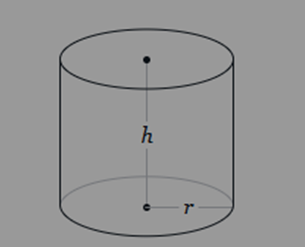
Volume of Cylinder Formula: The concept of cylinder volume and its formula. A cylinder's volume represents the amount of material it can contain or the quantity of any substance it can hold. This measurement is crucial, especially when dealing with objects like cylindrical containers. The volume of a cylinder can be calculated using the formula πr²h, where 'r' denotes the radius of the circular base, and 'h' signifies the height of the cylinder.This calculation applies whether you're dealing with a liquid or any other material that can fill the cylinder uniformly.
Also Check - Introduction to Euclid FormulaCylinder Volume in Detail
In mathematics and geometry, understanding the properties of different shapes is fundamental. Two essential properties of three-dimensional shapes like cylinders are volume and surface area. In this article, we'll primarily focus on volume and provide clear explanations along with solved examples to enhance your comprehension.
Also Check - Factorization Formula
Definition of a Cylinder
To start, let's define what a cylinder is. A cylinder is a three-dimensional shape characterized by a circular base. Think of it as a series of circular disks stacked atop one another. Now, imagine a scenario where you need to find out how much sugar can fit inside a cylindrical box. In essence, you are calculating the box's capacity or volume, which is equivalent to the volume of the cylinder it represents. Therefore, the volume of a three-dimensional shape corresponds to the amount of space it occupies.
Also Check - Logarithm Formula
Volume of Cylinder Formula
To calculate the volume of a cylinder, consider it as a collection of congruent disks stacked vertically. To find the total space occupied by the cylinder, calculate the space taken up by each individual disk and then sum them up. Therefore, the volume of a cylinder can be expressed as the product of the base area and the height:

Volume of a Cylinder Formula:
For any cylinder with a base radius 'r' and height 'h', the volume is equal to the base area multiplied by the height:
Volume = πr² × h
Hence, the volume of a cylinder equals πr²h cubic units.
Also Check - Ratio and Proportion FormulaVolume of a Hollow Cylinder
In the case of a hollow cylinder, where there are two radii involved (one for the inner circle and one for the outer circle formed by the base), the volume can be calculated as follows:
Volume of a Hollow Cylinder:
If 'r1' and 'r2' are the two radii of the given hollow cylinder with height 'h', then its volume can be written as:
V = πh(r 1 ² - r 2 ²)
Surface Area of a Cylinder
Another important aspect of a cylinder is its surface area, which represents the number of square units required to cover its outer surface. The formula for the surface area of a cylinder takes into account both the area of the circular bases and the lateral surface area:
Surface Area of a Cylinder Formula:
A = 2πr² + 2πrh
Volume of a Cylinder in Litres
When you calculate the volume of a cylinder in cubic centimeters (cm³), you can easily convert it into liters using the following conversion:
1 Litre = 1000 cm³
For instance, if a cylindrical tube has a volume of 12 liters, it can be expressed as 12,000 cm³.
Also Check- Sequence and Series Formula
Illustrative Examples
Example 1: Calculate the volume of a cylinder with a height of 10 cm and a base radius of 5 cm. (Assume π = 22/7)
Solution:
Given:
Height = 10 cm
Radius = 5 cm
Using the formula for volume:
V = (22/7) × 5 × 5 × 10
V = 785.714 cm³
Therefore, the volume of the cylinder is 785.714 cm³.
Example 2: Find the radius of the base of a cylindrical container with a volume of 440 cm³ and a height of 35 cm. (Assume π = 22/7)
Solution:
Given:
Volume = 440 cm³
Height = 35 cm
Using the formula for volume:
440 = (22/7) × r² × 35
r² = (440 × 7) / (22 × 35) = 4
Therefore, r = 2 cm
Then, the radius of the cylinder is 2 cm.
Volume of Cylinder Formula FAQs
What is the formula for calculating the volume of a cylinder?
How can I find the volume of a hollow cylinder?
What does the surface area of a cylinder represent?
How can I convert the volume of a cylinder from cubic centimeters to liters?
Can you provide a quick example of finding the volume of a cylinder?










